Cisco 8000 Series Router At-a-Glance
Available Languages
Bias-Free Language
The documentation set for this product strives to use bias-free language. For the purposes of this documentation set, bias-free is defined as language that does not imply discrimination based on age, disability, gender, racial identity, ethnic identity, sexual orientation, socioeconomic status, and intersectionality. Exceptions may be present in the documentation due to language that is hardcoded in the user interfaces of the product software, language used based on RFP documentation, or language that is used by a referenced third-party product. Learn more about how Cisco is using Inclusive Language.
Redefine routing with petabit scale, trust, and cloud-enhanced technology
Cisco® 8000 Series routers combine the Cisco revolutionary Silicon One™ Application-Specific Integrated Circuit (ASIC), IOS® XR7 software, and a new platform design to deliver a breakthrough in high-performance routers. Cisco Silicon One is the first routing silicon architecture to break through the 10-Tbps benchmark for network bandwidth. This is accomplished without sacrificing route capacity, packet-per-second forwarding performance, or feature flexibility. The first-generation Q100 ASIC delivers 10.8 Tbps of throughput in 16-nm process technology while the second-generation Q200 ASIC increases the performance to 12.8 Tbps in 7-nm process technology. Both ASICs deliver high-scale routing and deep buffering, which typically require off-chip memories.
The 8000 Series are highly scalable, deep-buffered, on-chip High Bandwidth Memory (HBM), 400G-optimized routers that range from 10.8 to 12.8 Tbps in a 1 RU footprint and are available in an industry-leading, rack-mountable modular system that is capable of 260 Tbps of full-duplex, line rate forwarding. Our innovations across silicon, optics, software, and systems facilitate high performance, high bandwidth, and low-power consumption without sacrificing any of the features service providers require.
The Cisco 8000 Series router is designed to benefit from the real-time analytics and operational insights delivered through Cisco Crosswork™ Cloud. With this cloud-enhanced network automation, the 8000 Series routers can reduce your operating costs.
Cisco 8000 Series routers enhance the security posture of your network by helping you measure, audit, verify, and enforce the trustworthiness of your network infrastructure. With a hardware-anchored root of trust, IOS XR7 security features, and remote security attestation, you can establish device integrity from boot time to run time. These features can help prevent the execution of unvalidated or malicious software across your network.
● Lower your network costs with breakthrough density and unprecedented scale and efficiency, so you can consolidate routers and reduce the total number of ports and optics
● Deploy terabits per second of routing capacity with service provider–class functionality and high availability, while dramatically reducing per-bandwidth power consumption
● Simplify your network operations with real-time analytics and insights delivered from Cisco Crosswork Cloud
● Measure, audit, verify, and enforce the trustworthiness of your critical infrastructure and enhance network security
Establish a new foundation for your network today
Imagine the possibilities if:
● Your network could scale anywhere with high performance
● The power of the cloud could improve your network operations and increase agility
● You could secure and protect your network by measuring, verifying, and enforcing the integrity of your network in real time
New network architectures that change the economics of the internet
Address even the most congested parts of your core network with the Cisco 8000 Series router fixed and modular chassis. The fixed platforms enable you to deploy a full-featured router in locations that traditionally required special accommodations for space, power, and cooling. The modular platforms enable you to scale your network with fewer routers and ports required in a given location.
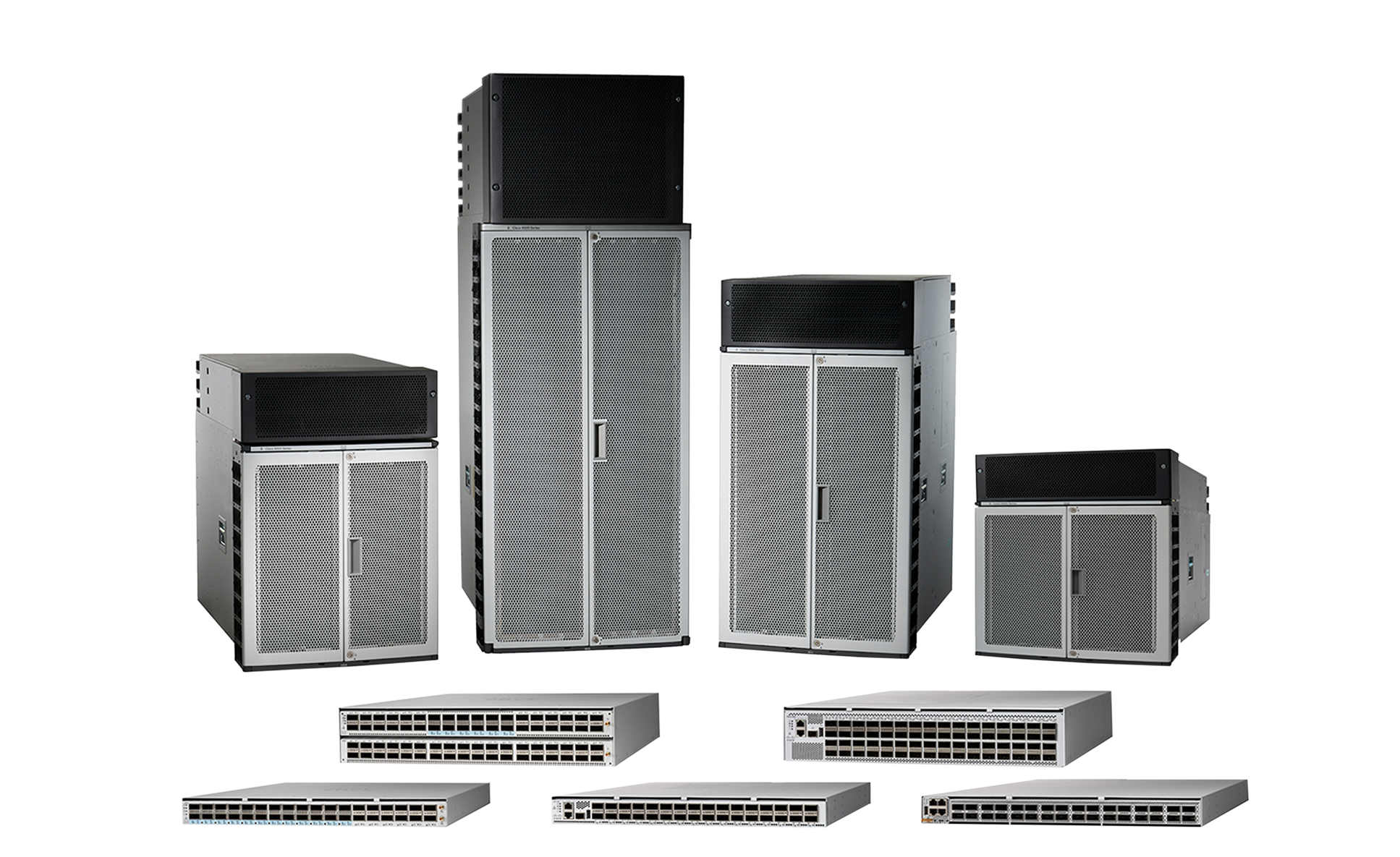
Cisco 8000 Series routers
● With scalable capacity and software-defined networking, you can converge custom network infrastructures and reduce the costs of building and operating mass-scale networks. With the Cisco 8000 Series router, you can transform your network into a multiservice infrastructure where each service gets its own dedicated networking slice with its own service-level agreements.
● Modernize your network automation with closed-loop, intent-based analytics. The analytics are delivered as a cloud service that provides insights without the traditional risk and cost associated with premises-based analytics. With Cisco Crosswork Cloud, you can accelerate new software deployment with automated and cloud-based test environments and gain improved visibility and control of network configurations and events by visualizing, reporting, and protecting the integrity of your network.
● Traditional approaches to network scaling and resiliency require complex capacity planning and operations. By building network fabric architectures with the Cisco 8000 Series routers, you can benefit from scalability, topological regularity, and operational simplicity.
The Cisco 8000 Series portfolio
New approaches to platform design
Taking advantage of more than 25 years of high-performance system design, the Cisco 8000 Series delivers industry-leading capacity without compromising performance or requiring oversubscription. The 8000 Series has new power supplies, a redesigned cooling architecture, and connectors that anticipate future capacity expansion.
The 8000 Series includes routers in both fixed and modular form factors to address a broad range of bandwidth needs and facility requirements.
Table 1. Cisco 8100 and 8200 Series fixed chassis options
| Fixed Chassis |
Bandwidth |
Height |
Ports |
Memory Options |
| Cisco 8101-32H |
3.2 Tbps |
1 RU |
32 QSFP28 100 GbE |
No HBM |
| Cisco 8102-64H |
6.4 Tbps |
2 RU |
64 QSFP28 100 GbE |
|
| Cisco 8101-32FH |
12.8 Tbps |
1 RU |
32 QSFP56-DD 400 GbE |
|
| Cisco 8201 |
10.8 Tbps |
1 RU |
24 QSFP56-DD 400 GbE and 12 QSFP28 100 GbE |
With HBM |
| Cisco 8202 |
10.8 Tbps |
2 RU |
12 QSFP56-DD 400 GbE and 60 QSFP28 100 GbE |
|
| Cisco 8201-32FH |
12.8 Tbps |
1 RU |
32 QSFP56-DD 400 GbE |
|
Cisco 8100 Series
The Cisco 8100 Series uses a single Cisco Silicon One ASIC in its Router-on-Chip (RoC) model from Cisco, which delivers full routing functionality. The Cisco 8100 Series is designed specifically for relatively low-power, low-buffer, and low-scale use cases. This no-HBM design yields unprecedented power efficiency with streamlined scale and buffer capacity.

Cisco 8101-32H

Cisco 8102-64H

Cisco 8101-32FH
The 8100 Series 1 and 2 RU footprints allow them to be deployed in locations that traditionally required much larger chassis and special accommodations for power and cooling. Provisioning up to 12.8 Tbps in the most efficient 100G/400G-generation chassis requires over seven times the space. The 8100 Series offers 1 and 2 RU systems in both 100G and 400G variants. The 8100 Series systems are designed with Cisco’s Q200 generation ASIC and does not have High Bandwidth Memory (HBM) on them. The streamlined scale and buffer capacity makes Cisco 8100 Series routers suitable for roles such as Top of Rack (ToR), high-density leaf and spines in data center networks, and IP Fabrics Leaf and Spine use cases.
Cisco 8200 Series
The Cisco 8200 Series uses a single Cisco Silicon One ASIC in its Router-on-Chip (RoC) model from Cisco as well to deliver full routing functionality. The Cisco 8200 Series is designed for relatively high-buffer and high-scale use cases. These systems are designed with on-chip HBM memory to achieve higher scale. To achieve similar routed bandwidth and scale, other industry routers require multiple devices such as off-chip Ternary Content-Addressable Memory (TCAMs) and fabric ASICs. However, the Cisco 8200 Series routers use a simple single ASIC (with HBM) design without the need for off-chip TCAM.
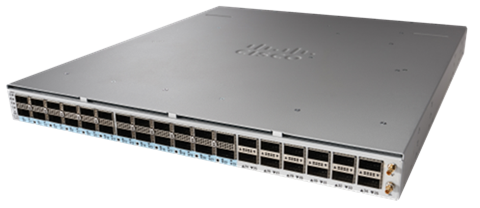
Cisco 8201
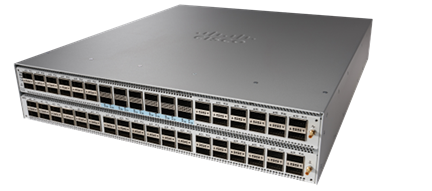
Cisco 8202

Cisco 8201-32FH
The 8200 Series 1 and 2 RU footprints allow them to be deployed in locations that traditionally required much larger chassis and special accommodations for power and cooling. Provisioning up to 12.8 Tbps in the most efficient 100G/400G-generation chassis requires over seven times the space. The 8200 Series provides tens of milliseconds of buffering and supports large forwarding tables. The ability to deploy a full-featured router into power- and space-constrained facilities such as colocation, Content Delivery Networks (CDNs), Internet Exchange Points (IXPs), or older central office sites opens new possibilities for network designs. The 8200 Series with its large buffer and scale capacity is most suitable for roles such as aggregation, peering, core, and Data Center Interconnects (DCIs).
Cisco 8800 Series
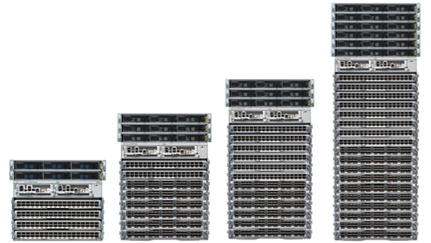
Cisco 8800 4-, 8-, 12-, and 18-slot modular chassis
The Cisco 8800 Series delivers density and efficiency with the extensive scale, buffering, and feature capabilities common to all the Cisco 8000 Series of routers. It includes three chassis to meet a broad set of network and facility requirements.
Table 2. Cisco 8800 Series modular chassis options
| Modular Chassis |
Bandwidth |
Height |
Supported Line Cards on All Chassis |
| Cisco 8804 |
57.6 Tbps |
4 slots/10 RU |
● 48 QSFP28 100 GbE line card with MACSec
|
| Cisco 8808 |
115.2 Tbps |
8 slots/16 RU |
● 34 QSFP28 100 GbE & 14 QSFP56-DD 400 GbE combo line card
|
| Cisco 8812 |
172.8 Tbps |
12 slots/21 RU |
● 36 QSFP56-DD 400 GbE
|
| Cisco 8818 |
259.2 Tbps |
18 slots/33 RU |
● 36 QSFP56-DD 400 GbE with MACSec
|
Cisco 8800 Series line cards
The Cisco 8800 Series modular platform supports five different 100 GbE and 400 GbE line cards. The line cards utilize multiple Cisco Silicon One forwarding ASICs to achieve high performance and bandwidth with line rate forwarding. All ports on all five line cards support different break out options for 100GbE, 40GbE, and 10GbE.
Table 3. Cisco 8800 Series line card options
| Line Cards |
Bandwidth |
Silicon |
100GbE Ports |
400GbE Ports |
MACSec |
| 8800-LC-48H |
4.8 Tbps |
Q100 |
48 |
- |
Yes |
| 88-LC0-34H14FH |
9 Tbps |
Q200 |
34 |
14 |
No |
| 8800-LC-36FH |
14.4 Tbps |
Q100 |
- |
36 |
No |
| 88-LC0-36FH |
14.4 Tbps |
Q200 |
- |
36 |
No |
| 88-LC0-36FH-M |
14.4 Tbps |
Q200 |
- |
36 |
Yes |
There are five different line cards supported on all 8800 modular chassis. The 48-port QSFP28 100 GbE line card provides 4.8 Tbps of throughput with MACsec support on all ports. It also supports QSFP+ optics for 10G and 40G compatibility.
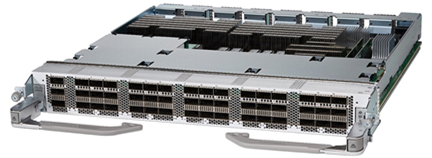
48-port QSFP28 100 GbE line card
The two variants of 36-port QSFP56-DD 400 GbE line cards are based on Q100 and Q200 silicon chips. Each line card provides 14.4 Tbps via 36 QSFP56-DD front-panel ports.
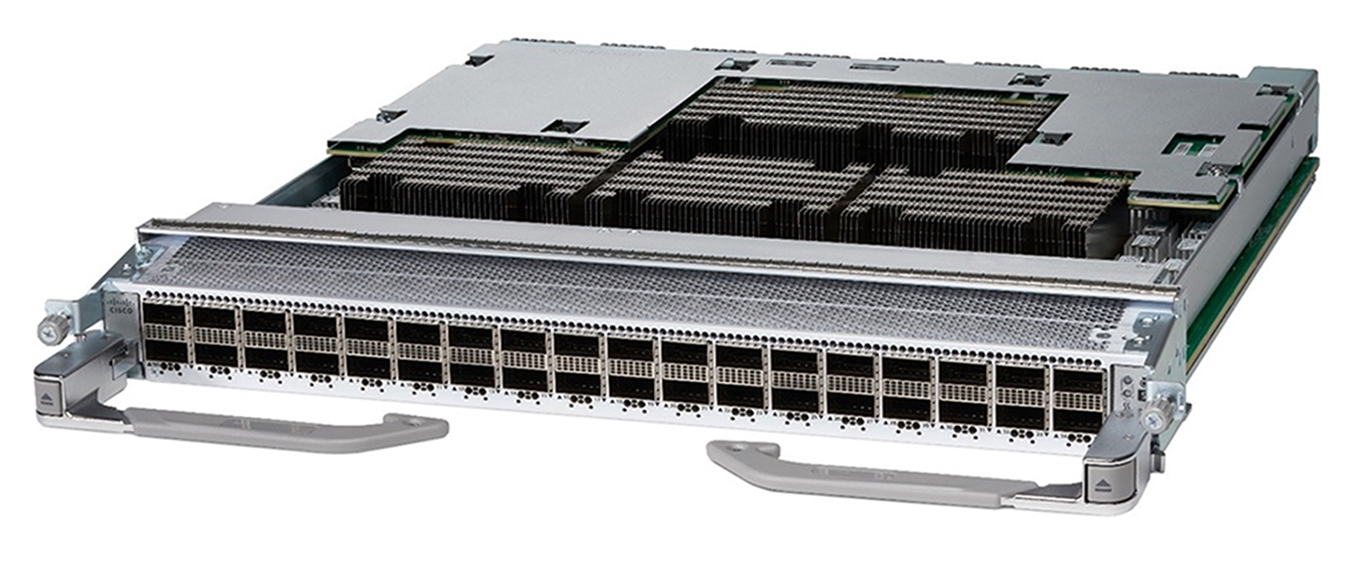
36-port QSFP56-DD 400 GbE line card
There is also a Q200-based, MACSec-capable, 36-port QSFP56-DD 400GbE line card that provides 14.4 Tbps of throughput with line rate MACSec on all ports.
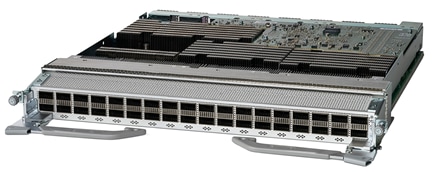
36-port QSFP56-DD 400 GbE line card with MACSec
All three 400 GbE line cards provide up to 144 ports of 100 GbE via breakout and support QSFP+, QSFP28, and QSFP28-DD modules.
In addition, there is a combo card that provides 34 - QSFP28 and 14 - QSFP56-DD ports. It offers customers the ability to smoothly transition from 100G to 400G.
Cisco 8800 Series switch fabric

The Cisco 8800 Series switch fabric is powered by 8 fabric cards that provide 7+1 line rate redundancy. In addition, the fabric supports a separate operational model with 4+1 fabric card redundancy to provide an entry-level option for systems with only the 48-port 100 GbE line card.
Security
Attacks on networking equipment can have disastrous results, and network operators need assurance that their equipment is secure and running authorized Cisco software.
Cisco secures the supply chain of every system at manufacturing time, so you can be confident that the hardware you receive from Cisco has no counterfeit components. In addition, every software image you download from Cisco is cryptographically signed using private keys. Advanced signing technology establishes software integrity, enforcement, and measurement.
Cisco IOS XR7
Cisco IOS XR7 provides a simple, modern, and trustworthy network operating system across your core, edge, aggregation, and access networks.
Improvements to the XR7 internal architecture have reduced the memory footprint by 50 percent, so XR7 can be installed with full security features on even constrained hardware designs without affecting boot times. Open, model-driven APIs at all layers of the software stack offer openness for programmability and customization to Cisco IOS XR7.
XR7 is an advanced network operating system that improves the security posture of the router. The Cisco Secure Boot subsystem verifies that the device boot image is genuine and untampered. Multiple run-time defenses within XR7 also guard against malicious actors and make exploitation of bugs more difficult.
Cloud enhanced
The Cisco 8000 Series routers are designed to benefit from the enhanced real-time analytics and operational insights delivered from Cisco Crosswork Cloud. These services include:
● Trust Insights: High-fidelity measurement, auditing, verification, and enforcement of network hardware and software trustworthiness
● Network Insights: Visibility and intelligence to assess network routing health
● Crosswork Qualification Environment: Automated and cloud-based environment to accelerate new software deployment
The Cisco Flexible Consumption Model uses the Cisco carrier-class IOS XR software and gives you the ability to:
● Reduce upfront capital: Achieve significant initial cost savings when you deploy new hardware equipment and the ability to add capacity as needed based on demand
● Simplify operations: Benefit from simplified license management and the carrier-class IOS XR software feature set
● Utilize capital efficiently: Share licenses network-wide with license pooling
● Protect investment: With investment protection on your current software purchases, you can scale to next-generation hardware to meet capacity growth over time
● Cisco 8000 Router Data sheet